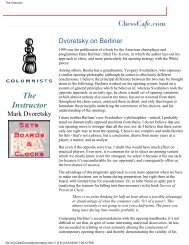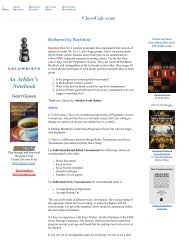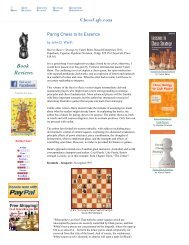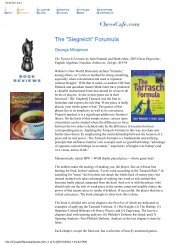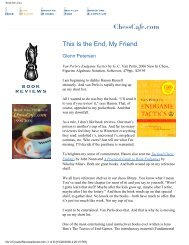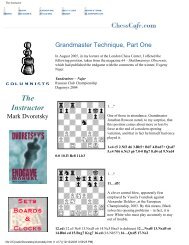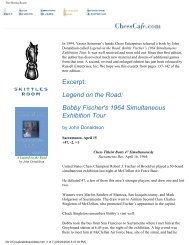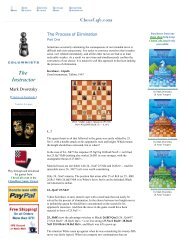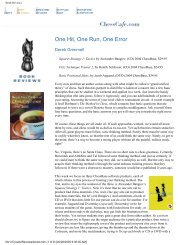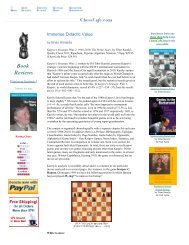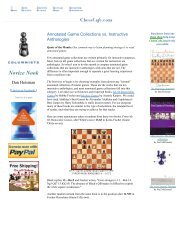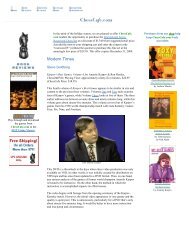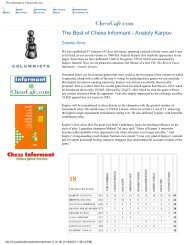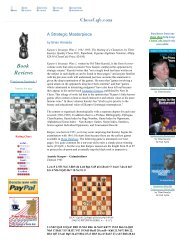You also want an ePaper? Increase the reach of your titles
YUMPU automatically turns print PDFs into web optimized ePapers that Google loves.
<strong>The</strong> <strong>Skittles</strong> <strong>Room</strong><br />
Adolf Albin and the Genesis of the Albin<br />
Counter Gambit Part I<br />
by Olimpiu G. Urcan<br />
file:///C|/cafe/skittles/skittles.htm (1 of 14) [10/4/2004 11:08:12 AM]<br />
Adolf Albin (1848-1920) was the subject of<br />
some articles published on the internet that<br />
invited further research. It has been our<br />
attempt to collect some of Albin’s games,<br />
and those of the other famous Romanian<br />
chess master, Georg Marco (1863-1923), in<br />
our book <strong>Chess</strong> Fathering a Nation<br />
published by Moravian <strong>Chess</strong>, Olomouc,<br />
2004. Far from being a faultless book,<br />
mostly due to some editing and proofreading<br />
shortcomings, I hope it at least<br />
offers an accurate image of the chess skills<br />
and the chess service performed by these<br />
two men, which was instrumental in<br />
Central European and Romanian chess<br />
history. Through their work both men<br />
established the foundation for chess in their<br />
native country. Marco, a chess scholar with<br />
great playing skills; and Albin, a chess<br />
Adolf Albin<br />
master with real writing skills; both<br />
anchored in the heart of the European chess tradition, worked to make chess<br />
more popular in the land between the Carpathian Mountains and the Black Sea.<br />
While they were chess masters for Europe and America they were chess parents<br />
for a nation.<br />
<strong>The</strong> present article intends to offer new information in the debate over the origins<br />
of the Albin Counter-Gambit (1.d4 d5 2.c4 e5). <strong>The</strong> source is a very rare chess<br />
manual Albin wrote in Romanian and published in 1872. <strong>The</strong>refore, it was<br />
unknown or inaccessible to many chess historians and researchers. [i] Today’s<br />
opinion of the Albin Counter-Gambit is that the line was made popular by Albin,<br />
when he employed it against Emanuel Lasker in 1893 at the New York<br />
Tournament, but he was not its creator. It is said that the gambit was introduced<br />
by Cavalotti Mattia against Salvioli in Milan in 1881. A series of historical and<br />
biographical works from Italy concluded that Serafino Dubois (1817-1899) first<br />
alluded to this line of play long before Cavallotti played it and a theoretical<br />
polemic erupted. In 1872 the second volume of Dubois’s work, Le Principali<br />
Aperture del Giuoco degli Schacchi, was published. <strong>The</strong> Italian chess historian
<strong>The</strong> <strong>Skittles</strong> <strong>Room</strong><br />
Adriano Chicco claimed that Dubois was the first who mentioned the countergambit<br />
on page 200 of his 1872 work, quoting: E’una mia scappata, e la dò per<br />
quel che vale, [ii] next to his indication of 1.d4 d5 2.c4 e5 3.e3 Bb4+. Chicco<br />
concluded that the testing of this idea continued and over the years was<br />
associated with Cavalotti’s and Albin’s name, but Dubois’s claim to its invention<br />
is undisputable. [iii] Certainly, this voids any real claim from Cavalotti, since<br />
Dubois’s work from 1872 originated the idea. But was Dubois the only one who<br />
thought about or made allusions to this counter-gambit? Albin’s contemporary<br />
chess editors were not aware of Dubois’s claim; Cavalotti’s being the one that<br />
monopolized the disputes. Albin wrote a few articles to defend his ideas, for<br />
instance in Neue Hamburger Zeitung’s chess column in 1904 and his fearless,<br />
and sometimes literary ruthless, attitude made him a difficult master to deal with.<br />
In Part Two of this article we will publish a sample of Albin’s disputes with<br />
Deutsches Wochenschach. [iv]<br />
Albin’s Romanian manual also appeared in 1872, which might challenge<br />
Dubois’s claim if further direct evidence is found to confirm our hypothesis. We<br />
believe that the Viennese chess columns from the 1870s and early 1880s likely<br />
contain some very early games of A. Albin that might confirm it; however, an<br />
earlier game of Albin’s still needs to be recovered.<br />
Lasker Em. – Albin A.<br />
New York-Impromptu Tournament, 1893<br />
Round 12<br />
Notes by Urcan Olimpiu<br />
file:///C|/cafe/skittles/skittles.htm (2 of 14) [10/4/2004 11:08:12 AM]<br />
1.d4 d5 2.c4 e5 Introducing this counter-gambit at a high international level.<br />
3.dxe5 d4 4.Nf3 (O.C. Muller – H.V. Crane, London, 1906 saw 4.a3 c5 5.f4 Nc6<br />
6.Nf3 Bf5 7.g3 Be7 8.Bg2 h5 9.0-0 h4 10.Qe1 hxg3 11.Qxg3 Rh6 12.Kh1 Rg6<br />
13.Qe1 Qd7 14.Rg1 0-0-0 15.Nbd2 Nh6 16.Nf1 Rh8 17.Bd2 Ng4 18.e4 Bxe4<br />
19.Ng5 Rgh6 20.Qg3 Rxh2 21.Nxh2 Rxh2 22.Qxh2 Nf2 mate; Or 4.e4 Nc6<br />
5.Nf3 Bg4 6.Bf4 f6 7.exf6 Nxf6 8.Bd3 Bb4+ 9.Bd2 0–0 10.0–0 Bxd2 11.Nbxd2<br />
Ne5 12.c5 Kh8 13.Qc2 Bxf3 14.Nxf3 Nxf3+ 15.gxf3 Nh5 16.Kh1 Rxf3 17.Qe2<br />
Qf6 18.e5 Qf4 19.Qe4 Qxe4 20.Bxe4 Rf4 21.Bxb7 Rb8 22.Bc6 Rxb2 23.e6 Nf6<br />
24.e7 Rb8 25.Rab1 Rc8 26.Rb7 Rf5 27.Re1 d3 28.Rxc7 Rb8 29.e8Q+ Nxe8<br />
30.Rxe8+ Rxe8 31.Bxe8 d2 32.Ba4 g6 33.Kg2 Re5 34.c6 Ra5 35.Bb3 Rxa2<br />
36.Rc8+ Kg7 37.Rg8+ Kf6 38.c7 1-0, Salvioli C. – Cavallotti M., Milano, 1881.)<br />
4…Nc6 5.a3 Capablanca gave 5.Nbd2 Bg4 6.h3 Bxf3 (8…Be6 is better.) 7.Nxf3<br />
f6 8.exf6 (8.e6!?) Nxf6 9.g3?! (9.a3!) in his annotations to Capablanca –<br />
Aurbach, Paris, 1914. He remarked in his annotations from Capablanca-<br />
Magazine (April-May, 1914): Although this counter-gambit is rarely played<br />
nowadays, it does not seem entirely bad. 5…Bg4 6. h3 Bxf3 7.gxf3 Nxe5 8.f4<br />
Nc6 9.Bg2 Qd7 10.b4 a6 11.Bb2 Rd8 12.Nd2 Nge7 13.Nb3 Nf5 Reinfeld and<br />
Fine gave 13...Ng6 14.b5 (14.Qd2 Bd6 (14...Qf5 15.Bxc6+ bxc6 16.Nxd4±)<br />
15.Nxd4 Bxf4 16.e3±) 14...Nxf4! (14...axb5 15.cxb5 Na7 (15...Nxf4 16.Bf3<br />
Ne5! 17.Nxd4 Nxf3+ 18.exf3 Bc5) 16.Qxd4! Qxb5 17.Qxa7 Qxb3 18.Qxb7<br />
Qxb7 19.Bxb7 Nxf4 20.Bc6+ Ke7 21.Bb5 Ne6 22.e3 and White should win.)<br />
15.bxc6 Nxg2+ 16.Kf1 Qxc6 17.Nxd4? Ne3+ and wins. 14.Qd3 Be7 15.Be4!<br />
Nd6 16.Nc5 Qc8 17.Bf3! If 17.Nxa6 then 17…Nxe4 18.Qxe4 0–0 19.b5 Rfe8!<br />
17…0-0
<strong>The</strong> <strong>Skittles</strong> <strong>Room</strong><br />
18.Rg1 Ne8 19.Nb3 Qd7 20. 0-0-0 Qd6<br />
21.Kb1 Qxf4 22.Rg4 Qh6 23.Bxc6 bxc6<br />
24.Rxd4 Rd6 25.c5 Re6 26.Qxa6 Qxh3<br />
27.R4d3 Qg2 28.Nd4 Rf6? 29.Re3 Bd8<br />
30.Nc2 Rxf2 31.Rxd8 1-0<br />
Source: Lasker’s Greatest <strong>Chess</strong> Games<br />
1889–1914, Dover Publications, New York,<br />
1965.<br />
N.N. – Albin A.<br />
Vienna, 1900<br />
1.d4 d5 2.c4 e5 3.dxe5 d4 4.e3 Bb4+ 5.Bd2 dxe3 6.Bxb4 exf2+ 7.Ke2 fxg1N+<br />
8.Ke1 Qh4+ 9.Kd2 Nc6 10.Bc3 Bg4 and White resigned in a losing position.<br />
Source: Wiener Schachzeitung, No. 1, 1902, p.14<br />
Chigorin M. – Albin A.<br />
Nuremberg, 1896<br />
1.d4 d5 2.c4 e5 3.dxe5 d4 4.Nf3 Nc6 5.g3 Bf5 6.Bg2 d3 7.e3 Nh6 8.0–0 Be7<br />
9.Nc3 0–0 10.b3 Qd7 11.Bb2 Rae8 12.Nd5 Bd8 13.Ba3 Be7 14.Nxe7+ Nxe7<br />
15.Nd4 c6 16.Bd6 Bg6 17.c5 Kh8 18.f4 Rg8 19.e4 f5 20.e6 Qd8 21.e5 Nc8<br />
22.Qxd3 Qa5 23.a3 a6 24.b4 Qd8 25.Rfe1 Ne7 26.Rad1 Qc8 27.Rd2 Rgf8<br />
28.a4 Rg8<br />
Any modern master playing black would<br />
resign here. Albin’s will to defend this<br />
hopeless position is remarkable. 29.b5 axb5<br />
30.axb5 Qa8 31.Bxe7 Rxe7 32.bxc6 bxc6<br />
33.Nxc6 Qc8 34.Nxe7 Qxc5+ 35.Kh1 Qxe7<br />
36.Qd6 Qa7 37.Rb1 Ng4 38.Qb6 Qa3 39.h3<br />
Qxg3 40.hxg4 fxg4 41.Rbd1 Qh4+ 42.Kg1<br />
g3 43.Rd8 Be8 44.Qd4 h5 45.Rd3 Rf8 46.e7<br />
Rg8 47.Rxe8 Rxe8 48.Qd7 Qxe7 49.Qxe7<br />
Rxe7 50.Rxg3 Rf7 51.e6 Ra7 52.Re3 Re7<br />
53.f5 Kh7 54.Rg3 Ra7 55.Rg6 Rc7 56.Be4<br />
h4 57.Kh2 Kh8 58.Kh3 Ra7 59.Kxh4 Kh7<br />
60.Bc6 Rc7 61.Bd7 Rc4+ 62.Rg4 1–0<br />
Schwarz A. - Albin. A.<br />
Vienna, 1899-1900<br />
file:///C|/cafe/skittles/skittles.htm (3 of 14) [10/4/2004 11:08:12 AM]<br />
1.d4 d5 2.c4 e5 3. dxe5 d4 4.g3 Nc6 5.f4 Bf5 6.a3 h5 7.Bg2 h4 8.Nf3 h3 9.Bf1<br />
a5 10.b3 Bc5 11.Bb2 Nh6 12.e3 Ng4 13.exd4 Ne3 14.Qc1 Nc2+ 15.Kd1<br />
N6xd4! 16.Nxd4 Bxd4 17.Nd2 Bf2! Black is threatening 18…Ne3+ 19.Ke2<br />
Qd3+ 20.Kxf2 (If 20.Kf3 then 20…Nxf1+ 21.Kxf2 Qe3+ 22.Kxf1 Bd3 mate.)<br />
20…Ng4+ 21.Ke1 Qe3+ 22.Be2 Qd2+ 23.Kd1 Ne3 mate! 18.Qxc2 Bxc2+<br />
19.Kxc2 Bd4 20.Nf3 Bxb2 21.Kxb2 a4 22.b4 Qd7 23.Be2 Qc6 24.Rac1 Qe4<br />
25.Rhe1 Qe3?! (25…0-0-0!) 26.Rc3 Qf2 27.Rc2 0-0-0 28.Bd1 Qxe1 29.Nxe1
<strong>The</strong> <strong>Skittles</strong> <strong>Room</strong><br />
Rxd1 30.Nf3 Rd3 31.Ng5 f6 32.exf6 gxf6 33.Ne4 Rhd8 34.Nc5 Why not<br />
34.Nxf6? If 34…Rd2 then 35.Nd5. 34…Rd2 35.Nxa4 Rxc2+ 36.Kxc2 Rg8<br />
37.Nc5 Rxg3 38.Ne4 Rg2+ 39.Kd3 Rxh2 40.Nxf6 Rg2 0-1<br />
Source: Bachman, Schachjahrbuch, 1899, vol.2, p. 36<br />
Teichmann R. – Albin A.<br />
Monte Carlo, 1902<br />
1.d4 d5 2.c4 e5 3.e3 Bb4+? 4.Nc3 e4? 5.cxd5 Qxd5 6.Bd2 Bxc3 7.bxc3 a5<br />
8.f3?! Nf6 9.Qb3 Qd6 10.Bc1 (10.a4!) 10…a4 11.Qc2 Qe7 12.fxe4 Nxe4<br />
13.Nf3 O-O 14.Bd3 f5 15.O-O Nd7 16.Rb1 c6 17.c4 h6 18.g3 g5 19.Bd2 c5<br />
20.Bxe4 fxe4 21.Ne5 Rxf1+ 22.Rxf1 Nxe5 23.dxe5 Bh3 24.Rf6 Rf8 25.Bc3<br />
Rxf6 26.exf6 Qd7 27.Kf2 Qf5+ 28.Ke1 Qf1+ 29.Kd2 Qxc4 30.Kc1 Kf7 31.Be5<br />
Qd5 32.Bc3 b5 33.a3 Bg4 34.Qd2 Qc4 35.Kb1 Be6 36.h4 Qb3+ 37.Qb2 Qd1+<br />
38.Qc1 Ba2+? 38…Qd3+ and 39…Qc4 offered winning chances. 39.Kb2 Qd5<br />
40.hxg5 hxg5 41.Ka1 Bb3 42.Qh1 Qd1+ 43.Qxd1 Bxd1 44.Be5 Ke6 45.f7<br />
Kxf7 46.Bd6 c4 47.Kb2 Ke6 48.Bb4 and drawn at move 69.<br />
Source: Monte Carlo 1902, A.J. Gillam (ed.), <strong>The</strong> <strong>Chess</strong> Player, 1997, p. 64-65<br />
Meitner – Albin A.<br />
Vienna, 1904<br />
file:///C|/cafe/skittles/skittles.htm (4 of 14) [10/4/2004 11:08:12 AM]<br />
1.d4 d5 2.c4 e5 3.cxd5 Qxd5 4.dxe5 Qxe5 5.Nf3 Bb4+ 6.Nbd2 Qa5 7.e3 Bg4<br />
8.Bc4 Better is 8.Be2. 8…Nf6 9.0-0 Nc6 10.Qb3 0-0 11.a3 Bd6 12.Qxb7 Ne5<br />
13.Nxe5 Qxe5 14.g3 Rab8 15.Qg2 Qh5 16.Rfe1 Be5 17.Ra2 Rfd8 18.f4 Bd6<br />
19.Be2 Bc5! 20.Bxg4 Nxg4 21.Ne4 If 21.Nf1 then 21…Rb3 with great pressure.<br />
21…Rd1! 22.Rxd1 Nxe3 23.Bxe3 Bxe3+<br />
24.Nf2 Qxd1+ 25.Qf1 Bxf2+ 26.Kxf2 Qd4+<br />
and a2-rook is lost. 0-1<br />
Source: Bachmann, Schachjahrbuch, 1904, p.<br />
162<br />
As with his Schach-Aphorismen und<br />
Reminiscenzen (containing drawings and 14<br />
games published in 1899), Albin’s Amiculu’<br />
Jocului de Schach. <strong>The</strong>oreticu si Practicu<br />
(Bucuresti, 1872) is a prized collector’s item.<br />
A rare chess manual for amateurs, it is the<br />
first chess book printed in Romanian. It was published with the help of Manole<br />
Costache Epureanu, a preeminent political and cultural character in the old<br />
Bucharest. One of the surviving originals can be found at Lucian Blaga Central<br />
Library, Babes Bloyai University (Cluj Napoca, Romania), in the heart of<br />
Transylvania. It has 42 pages and is in very good condition. <strong>The</strong> library staff<br />
even used to lend it out for home study, but now it is considered a historical<br />
manuscript and handled with extreme care.
<strong>The</strong> <strong>Skittles</strong> <strong>Room</strong><br />
file:///C|/cafe/skittles/skittles.htm (5 of 14) [10/4/2004 11:08:12 AM]<br />
Albin’s chess manual written in the old Romanian<br />
language and published in 1872<br />
<strong>The</strong> passage that follows is from the Amiculu’ Jocului de Schach. <strong>The</strong>oreticu si<br />
Practicu (Bucuresti, 1872):<br />
Gambits are very interesting. <strong>The</strong> one who is offering the gambit – the one who<br />
is intentionally giving up the pawn – through this sacrifice is preparing a better<br />
ground for his pieces to create vivacious attacks. His opponent is forced to<br />
sacrifice some of the pieces as he is dealing with an attack. <strong>The</strong> struggle is<br />
hopeless since the one who offered the gambit is fiercely attacking, while the<br />
other is weaker and confronted with the mission of a difficult defence and<br />
expectant attacking chances.<br />
<strong>The</strong> opinions on this matter are diverse regarding who will win or how the draw<br />
occurs in such a game when two equally matched opponents are facing each<br />
other on the chessboard.<br />
La Bourdonais [sic] says that ‘the one who is receiving the gambit – that is the<br />
one who is taking the pawn – has to win’. Philidor noted that ‘a Gambit in which<br />
the attacks and the defences are equal should end up as a draw’. Allgaier<br />
observed that ‘So far I conclude that a good defence against a Gambit is not<br />
known yet to me’.<br />
My last enduring study and experience has persuaded me that if these Gambit<br />
games are played with finesse, then the opponent can hardly even earn a draw,<br />
and can never win unless some better defence is discovered, on the tail of<br />
which I am finding myself right now and which I hope to share in the second<br />
edition of this brochure if this initial edition is encouraged by intelligent<br />
amateurs of the game”. [emphasis added]<br />
Considering the closing words of the book, it can be argued that there was a need<br />
for commerce and publicity so that the next edition would sell as well as the first<br />
one. This must have convinced Albin to tempt the reader in such a way. If so,
<strong>The</strong> <strong>Skittles</strong> <strong>Room</strong><br />
then it would be the only ‘marketing’ sentence in the whole booklet! Plus, if you<br />
wanted to tempt beginners in chess, then a promise about opening traps or how to<br />
win easily in the opening stage would do the trick.<br />
What was this “better defence” he was working on and mysteriously concealed?<br />
A better defence against the gambits implies a new way of approaching them,<br />
and it was at this time that counter-gambits started to become fashionable. Albin<br />
undoubtedly had in mind a counter-gambit.<br />
Was Albin referring to his counter-gambit that begins with 1.d4 d5 2.c4 e5? His<br />
words appear in the context of a discussion on the value of gambit games and<br />
what the chances for each side are. <strong>The</strong> most popular gambits of his time were<br />
the King’s Gambit and the Queen’s Gambit. After reviewing the authorities’<br />
opinions, Albin advanced his own ideas and disclosed the fact that he was<br />
studying an improved system. Interesting enough Labourdonnais is quoted first<br />
and he was one of the first adepts of the Queen’s Gambit. Albin also wrote these<br />
lines when the Falkbeer Counter-gambit (1.e4 e5 2.f4 d5) was enjoying a<br />
moment of popularity, which stands as a mirror reflection of the Albin Counter-<br />
Gambit.<br />
If Albin was writing about 1.d4 d5 2.c4 e5 then the date, place and source of its<br />
origin should be revisited. Cavalotti was wrong to claim a monopoly on the idea.<br />
And, claiming a similar monopoly for Dubois can be misleading as well. Such a<br />
thesis needs further evidence as “one cannot raise a mountain with a fist of sand”<br />
as the old saying goes. Nevertheless, this significant passage raises some useful<br />
questions for further inquiry. Albin had very few chances to meet 1.d4 with<br />
Black prior to the 1890s and in his first encounter with a heavy-weight player<br />
(Em. Lasker) he played his invention. Here are some secondary arguments<br />
supporting this theory.<br />
I. Albin’s <strong>Chess</strong> Beginnings Revisited<br />
<strong>Chess</strong> Monthly (1894) claimed that Albin learned the game in 1870. [v] Albin, on<br />
the other hand, in 1872 in his Romanian manual mentions his “last enduring<br />
study and experience.” Two years of chess study would not be enough to write<br />
such words. It seems logical that Albin played chess in Vienna during the late<br />
1850s and early 1860s while completing his business studies. Potential games<br />
might be recovered by someone with access to the Austrian archives.<br />
Quarterly for <strong>Chess</strong> History (8/2003 pp. 499-500) offered three early games of<br />
his from tournaments played in Vienna and Budapest, the earliest from 1883;<br />
while the <strong>Chess</strong>base mega-database indicates 1890 as the year of Albin’s earliest<br />
games. Below we offer several games recovered from Albin’s so called “early<br />
period” – prior to 1890. An undeniable fact in his game from 1883 is that Albin’s<br />
playing strength is that of an already experienced player. Remarkably, even his<br />
earliest games show his enthusiasm for offering pawns in the opening and<br />
playing gambit-style lines.<br />
Albin A. – Schindler F.<br />
Vienna, 1883<br />
file:///C|/cafe/skittles/skittles.htm (6 of 14) [10/4/2004 11:08:12 AM]<br />
1.Nf3 Nf6 2.d4 d5 3.Bg5 e6 4.e4 Nc6 5.Bb5 Be7 6.Nbd2 dxe4 7.Bxf6 Bxf6
<strong>The</strong> <strong>Skittles</strong> <strong>Room</strong><br />
8.Nxe4 Bd7 9.O-O O-O 10.Nxf6+ Qxf6 11.Ne5 Qe7 12.Nxd7 Qxd7 13.c3<br />
Rad8 14.f4 a6 15.Bxc6 Qxc6 16.f5 Rd7 17.f6 g6 18.Qd2 Kh8 19.Qh6 Rg8<br />
20.Rf3 Rd5 21.g4 Rh5 22.Qe3 Rh4 23.h3 g5 24.c4 Rh6 25.Rd1 Qxc4 26.Rc1<br />
Qxa2 27.Rxc7 Qb1+ 28.Rf1 Qxb2 29.Rxf7 Qb6 30.Qe5 Rxh3<br />
31.Rf8 1-0<br />
Source: Wiener Schachzeitung, No.2, 1887,<br />
p.32<br />
Albin A. – de Riviere<br />
Paris, 1888<br />
1.e4 e5 2.Nc3 Nf6 3.f4 d5 4.fxe5 Nxe4 5.Nf3<br />
Black has a good game after 5.Qf3 f5<br />
followed by 6…Nc6. 5…f5 6.d4 Bb4 7.Bd2<br />
Nxd2 8.Qxd2 0-0 9.Bd3 Nc6 10.a3 Be7<br />
11.h4 Be6 12.Ne2 a6 Better would have been<br />
12…Qd7. 13.Nf4 Qd7 14.c3 Na5 15.Ng5 Bxg5 16.hxg5 Nb3 17.Qd1 Nxa1<br />
18.Rxh7! (see next diagram)<br />
1, 1891, p. 1<br />
Albin A. – Bauer J.H.<br />
Vienna, 1891<br />
file:///C|/cafe/skittles/skittles.htm (7 of 14) [10/4/2004 11:08:12 AM]<br />
18…Kxh7 19.Qh5+ Kg8 20.g6 Rfc8<br />
21.Bxf5! Bxf5 22.Qh7+ Kf8 23.Qh8+ Ke7<br />
24.Qxg7+ Kd8 25.Qf8+ Qe8 26.Qxf5 is<br />
winning for White. 18…Bf7 19.g4! Bg6<br />
20.Nxg6 Kxh7 21.Nxf8+ Better was 21.gxf5!<br />
and if 21…Rxf5 then 22.Qh5+ Kg8 23.Bxf5.<br />
21…Rxf8 22.gxf5 g6 23.f6 Qh3 24.Qa4! c6<br />
25.Qb4 Qg3+ 26.Ke2 Rf7 27.Qd6 Qg4+<br />
28.Ke1 Qg1+ 29.Ke2 Qxg5 30.Qd8 Qg4+<br />
31.Ke1 Qd7? 32.Qxd7 Rxd7 33.e6 Rd6<br />
34.e7 Re6+ 35.Kd1 1-0<br />
Source: Frankfurter Schachzeitung, August<br />
1.Nf3 Nf6 2.c4 e6 3.e3 b6 4.Be2 Bb7 5.b3 d5 6.Bb2 Nbd7 7.0-0 Bd6 8.d4 Ne4<br />
9.Nbd2 Qf6 10.Nxe4 dxe4 11.Ne1 Qh6 12.g3 Qg5 13.Ng2 h5 14.h4 Qh6 15.f4<br />
f5 16.Ne1 Qg6 17.Kh2 Nf6 18.b4! 18…Bxb4 is met with 19.Qa4+. 18…c6<br />
19.Qb3 Be7 20.Ng2 Rh6 21.c5 Ng4+ 22.Kg1 Kf7 23.a4 Nf6 24.Kh2 Ng4+<br />
25.Kh3 Rhh8 26.Rac1 Nf6
<strong>The</strong> <strong>Skittles</strong> <strong>Room</strong><br />
1891, p. 1<br />
27.Ne1! Activating this Knight via e1-c2-a3c4-d6.<br />
27…Nd5 28.Nc2 Rhb8 29.Na3 bxc5<br />
30.Nc4! Bf6 31.dxc5 Ba6 32.Nd6+ Kg8<br />
33.b5 Be7 34.Be5 Bxd6 35.Bxd6 Rb7<br />
36.Be5! cxb5 37.c6 Rb6 38.a5 R6b8<br />
39.Bxb8 Rxb8 40.c7 Advancing the pawns<br />
on the queenside wins the game. 40…Rc8<br />
41.Rc6 Bb7 42.Qxd5 Qg4+ 43.Bxg4 hxg4+<br />
44.Kg2 exd5 45.Rc5 a6 46.Kf2 Kf7 47.Ke2<br />
Ke6 48.Kd2 Kd6 49.Rfc1 g6 50.R5c2 Kd7 1-<br />
0<br />
Source: Frankfurter Schachzeitung, March 8,<br />
II. Genuine Originality in the Opening<br />
Closely related to the need for a reassessment of Albin’s chess beginnings comes<br />
the matter of his eccentricity in the openings. In his game against Csank in 1892,<br />
Albin introduced the so-called Alekhine-Chatard Attack in the French Defence<br />
(1.e4 e6 2.d4 d5 3.Nc3 Nf6 4.Bg5 Be7 5.e5 Nfd7 6.h4!?), which was later<br />
popularized by Alexander Alekhine. Albin also contributed heavily to the<br />
development of the Albin-Blackburne counter-gambit in the Philidor Defence<br />
(1.e4 e5 2.Nf3 d6 3.d4 Bg4 4.dxe5 Nd7!?) as Stefan Bucker correctly indicated<br />
in one of his theoretical articles. [vi] <strong>The</strong> game below, played during a<br />
simultaneous exhibition, stands as incontestable proof that in 1885 Albin was<br />
already studying this line:<br />
Strasser L. – Albin A.<br />
Vienna, 1885<br />
Simultaneous Exhibition with clocks<br />
Notes by Brüderschaft<br />
This game was played by Albin in an exhibition against 17 players. (…) Fifteen<br />
Austrian schillings were bet against Adolf Albin by the audience regarding the<br />
chances of his pawn sacrifice from the Philidor Defence.<br />
1.e4 e5 2.Nf3 d6 3.d4 Bg4 4.dxe5 Nd7<br />
file:///C|/cafe/skittles/skittles.htm (8 of 14) [10/4/2004 11:08:12 AM]<br />
This pawn sacrifice – giving Black good play<br />
– is called the Albin Variation. 5.exd6 Bxd6<br />
6.Bd3 Ne5 7.Nbd2 Nf6 8.h3 Bh5 9.g4<br />
Nxf3+ 10.Nxf3 Bg6 11.e5 This move allows<br />
Black very interesting play. 11...Bb4+ 12.c3<br />
Bxd3 13.exf6 Bc5 14.Ne5 Qd5 15.Qxd3<br />
Qxh1+ 16.Ke2 0–0 17.Qf3 Qxf3+ 18.Kxf3<br />
Rfe8 19.Bf4 Bd6 20.Nc4 Bxf4 21.Kxf4<br />
Rad8 22.Ne3 Rd2 23.f3 Rd3 24.Nf5 Re2<br />
25.b3 gxf6 26.c4 c5 27.Rg1 Re5 This move<br />
was very good because White had very little<br />
time left. 28.g5 Rxf5+ 29.Kxf5 Rxf3+<br />
30.Kg4 Rf2 31.gxf6 Rxf6 32.Rg2? Rg6+ 33.Kf3 Rxg2 34.Kxg2 Kg7 35.Kf3<br />
Kf6 36.Kg4 Ke5 37.Kg5 f5 0-1
<strong>The</strong> <strong>Skittles</strong> <strong>Room</strong><br />
Source: Brüderschaft, 28.12.1885, p. 150<br />
Albin also patented a plan of advancing the queenside pawns in the Italian Game,<br />
after 1.e4 e5 2.Nf3 Nc6 3.Bc4 Nf6 4.d3 Bc5 5.c3 d6 6.b4 Bb6 7.a4 a6 8.a5 Ba7<br />
9.Be3, this is another one of Albin’s “pets” as Tarrasch called it. [vii]<br />
<strong>The</strong> Romanian chess master often played openings or consciously chose lines<br />
considered inferior – at the Budapest Tournament in 1896 he played 1.e4 b6!?<br />
against Janowski, [viii] and in 1905 at Vienna he played 1.e4 Nf6 2.e5 Ng8<br />
against Nimzovitch. In the match against Delmar at the Manhattan <strong>Chess</strong> Club in<br />
1894 Albin played 1.d4 e6 2.e3 b6 in the 5th game. [ix] And Brody M. – Albin<br />
A., Vienna 1899 saw the exceedingly original 1.e4 e5 2.Nf3 a6 3.Nxe5 Qe7.<br />
With White he played 1.e4, 1.d4, 1.Nf3, 1.f4, or even 1.d4 d5 2.Bf4 c5 3.Bxb8<br />
against Schlechter at Vienna in 1905. In New York in 1895 he engaged in<br />
thematic consultation games defending Black in several apparently inferior<br />
variations of the Evans Gambit.<br />
Below is one of Albin’s theoretical novelties from his famous win over Tarrasch<br />
at Dresden in 1892. <strong>The</strong> reactions caused by this game are instrumental for<br />
deducing Albin’s character and playing style.<br />
Albin A. – Tarrasch S.<br />
Dresden, 1892<br />
file:///C|/cafe/skittles/skittles.htm (9 of 14) [10/4/2004 11:08:12 AM]<br />
1.e4 e5 2.Nf3 Nc6 3.Bc4 Bc5 4.c3 Nf6 5.d4 exd4 6.cxd4 If 6.e5 then 6…d5!<br />
7.Bb5 Ne4 8.cxd4 Bb6 9.Nc3 0-0 10.Be3 Ne7 and Black has no problems.<br />
6…Bb4+ If 6…Bb6? then 7.d5 Ne7 (7…Na5 8.Bd3!) 8.e5 Ng4 9.d6! 7.Bd2<br />
Nxe4 7…Bxd2+ or 7…d5 seems more normal, as Tarrasch himself wrote:<br />
Usually 7…Bxd2+ is played. I adopted the text move many times in Nuremberg<br />
and not without success. 8.Bxb4 Nxb4 9.Bxf7 Kxf7 10.Qb3+ d5 11.Ne5+ Kf6?<br />
A move proposed by Vitzthum and recommended by Max Lange. Bilguer also<br />
called it a correct move, which along with the next two moves, creates the main<br />
idea of Black’s defence. Kieseritsky in his match against Buckle in Paris, 1848<br />
invariably played 11…Ke7. However, it seems that Dr. Schmidt’s<br />
recommendation is better: 7…Ke6! 8.Qxb4 c5 9.Qa4 Qb6! 12.Qxb4 c5 13.Qa4<br />
Qe8?! Again 13…Qb6 seems more precise. 14.Qd1!<br />
A theoretical novelty; Tarrasch noted: This<br />
move secures a positional advantage for<br />
White in all variations. So called “theoretical<br />
analyses” only considers here the exchange<br />
of Queens, when Black has a good game.<br />
Tarrasch also wrote in his Dreinhundredt<br />
Schachpartien, Leipzig, 1895: I carelessly<br />
played a little known line from Bilguer. My<br />
opponent, instead of making the weak reply<br />
according to theory, immediately found a<br />
much better one and reached an<br />
advantageous position. Thus I lost a game<br />
because of my good memory and the bad one of my opponent!
<strong>The</strong> <strong>Skittles</strong> <strong>Room</strong><br />
file:///C|/cafe/skittles/skittles.htm (10 of 14) [10/4/2004 11:08:12 AM]<br />
And <strong>Chess</strong> Monthly, 1893-94 wrote: He happened to have analysed this<br />
particular variation of the Giuco Piano with the late Herr Gelbfuhs, and so<br />
inflicted the only defeat the Doctor sustained in three consecutive International<br />
Tournaments. 14…Ng5 If 14…cxd4 White will play 15.f4 and then capture the<br />
pawn from d4. Chigorin suggested 14…g6 as 14…cxd4 15.f4 g5 16.g3 followed<br />
by 17.Qxd4 is insufficient. 15.f4 Ne6 16.Nc3 g6 17.Nxd5+ Kg7 18. 0-0 cxd4<br />
19.f5! Nf4 20.f6+ Kf8 21.Ne7 Qb5 22. Rxf4! <strong>The</strong> best way; 22.Qe1 fails to<br />
22…Ne2+ 22…Qxe5 23.Qxd4 Qxd4 24.Rxd4 Be6 25.Rd6! Kf7 26.Rae1 Bxa2<br />
27.Nd5! Rhd8 28.Re7+ Kf8 29.Rxd8+ Rxd8<br />
30.Nc3 Bf7 31.Rxb7 a6 32.Ra7 Rd2<br />
33.Ne4! Rxb2 34.Ra8+ Be8 35.Nd6 1-0 If<br />
35…Re2 then simply 36.f7. <strong>The</strong> British<br />
<strong>Chess</strong> Magazine noted: Herr Albin was<br />
warmly congratulated after his victory.<br />
Source: British <strong>Chess</strong> Magazine, 1892, p.<br />
361.<br />
<strong>The</strong> atmosphere of this game is described in<br />
SAH, No.25/1948, on page 793 as follows:<br />
Indeed, it was not expected that one - so far –<br />
nearly unknown master succeeded in defeating Tarrasch. In a Ruy Lopez game,<br />
Albin playing with White came into a better position. At once the news spread in<br />
the playing hall: "Tarrasch is losing!" As in that time there was no<br />
demonstration wall boards, numerous spectators rushed toward the board on<br />
which Albin and Tarrasch struggled. Moreover, the participants of the<br />
tournament left their games to see the sensational event. Only Master Shotlender<br />
stayed seated in his place with his failing position, looking at the ceiling, as if he<br />
was expecting salvation from there. <strong>The</strong> nicely ornamented tournament room<br />
provided a warlike appearance when the struggle for the vicinity of the table<br />
with the chess game Albin - Tarrasch began. Improvised protection bands were<br />
crushed, and they quickly dragged tables onto which they piled chairs so that the<br />
audience could stand on them. In that way whole pyramids of tables and chairs<br />
were created and adorned by excited spectators. Among the mob of the several<br />
hundreds of spectators, Albin made his winning move. <strong>The</strong> opponent was left<br />
with no salvation. Tarrasch thought for a long time and made a few more moves.<br />
After that he crushed his pieces down, made a sign of capitulation, and went out<br />
through the door.<br />
<strong>The</strong> applause reverberated in the tournament hall. Somebody was found who<br />
could beat Tarrasch. <strong>The</strong> biggest daily newspapers from different parts of the<br />
world asked to receive the game by telegraph. And Emanuel Lasker, Tarrasch’s<br />
main rival, congratulated Albin by dispatch. After several days, Tarrasch, tired<br />
and a bit angry, found the occasion to give credit to the winner. <strong>The</strong> grand<br />
master wrote: "I had no bad foreboding when I played a weakly known line from<br />
Bilguer’s textbook. But, my opponent didn’t know the line at all. Owing to that<br />
fact, his moves were much stronger than the ones noted in that textbook and he<br />
came to advance. I lost the game only because of my good memory and<br />
opponent’s ignorance.<br />
Some annotators and well-known players, including Emanuel Lasker, suggested<br />
that this was an accident. Here is Albin’s complete letter of reply sent to the<br />
Wiener Schachzeitung editors and published in the issue No.7-8/1908, p. 196
<strong>The</strong> <strong>Skittles</strong> <strong>Room</strong><br />
199:<br />
file:///C|/cafe/skittles/skittles.htm (11 of 14) [10/4/2004 11:08:12 AM]<br />
<strong>The</strong>se words are coming from the warm heart of a man dominated by<br />
implication, who is not confusing a sad fate with inability or lack of gift, as is<br />
often done by some men of simple naivety when they don’t receive the whole<br />
amount of won games to quench their appetite. This is their whole<br />
understanding! But things are different with respect to Lasker’s creational<br />
power! He is satisfied with the productivity of isolated moves for evaluating one<br />
master. <strong>The</strong> fact that I did not manage to produce anything great is because of<br />
my unhappy family situation, for which I do not blame anyone, of course. I was<br />
not quite ready for the whole charge of complete analysis and semi-draws.<br />
Today, to create is not a task easily accomplished by all.<br />
Now on the game from Dresden and about the fall of Mr. Tarrasch: At that time,<br />
the game produced a lot of clamour among the theoreticians and scholars, as it<br />
provoked the stupefaction of all the philistines from chess and a lot of angst in<br />
the camp of Tarrasch’s supporters. I have to confess that such a deep loyalty<br />
moved me greatly and through it I became more aware of the importance of this<br />
victory. I did not accord too much significance to this game myself. For me it<br />
was just a good game, like many others.<br />
My whole audacity - that to win against the invincible – consisted in the fact that<br />
I did not follow the same chess habits as many did against Tarrasch, but I chose<br />
to follow my own path into a variation which was regarded as wrong by theory.<br />
Here is the game which generated so much emotion and interest in the world of<br />
chess. I am asking now: where is the luck in this perfectly played game? It is<br />
possible that Mr Tarrasch – so much used to relying on complete analysis –<br />
became a bit jumpy because of my independence, but his game was lost after<br />
Qa4-Qd1. As to luck – that is out of question. Moreover, this game was<br />
disadvantageous for me since the organizer of the event – Mr Zwanzig (may he<br />
rest in peace) – seeing my advance in the first week, when I was the leader, and<br />
being a bit worried about Mr Tarrasch – his favourite, thought he could do<br />
something for Tarrasch and obliged me to play three adjourned games in the<br />
same day. This extra-effort meant a chance for Mr Tarrasch; otherwise I would<br />
have had a word to say in relation with the prizes, considering my good form at<br />
that point.<br />
Nevertheless, I have never refused my admiration for the German grandmaster,<br />
Dr. Tarrasch, and I expressed my admiration for his skills in the games against<br />
Marshall with the most objectivity in Neue Hamburger Zeitung. But now it’s<br />
gone too far, with some exaggerating that my victory was “accidental”, as<br />
quoted in Lasker’s letter. I deeply refute that with all the respect I have for the<br />
world master, Dr. Lasker, whom I knew as a noble man and a good friend.<br />
Respectable editor, next to my gratitude for publishing these lines, please find my<br />
highest appreciation and the honour to sign as<br />
Yours Sincerely,<br />
Ad. Albin<br />
Every now and then, to initiate an innovation, it is helpful not to know what the<br />
books say. Independence, originality in thinking, and a flexible approach to the
<strong>The</strong> <strong>Skittles</strong> <strong>Room</strong><br />
game were serious assets for Albin. Tarrasch was reduced to a student following<br />
the book and learning the hard way that the book recommendation was wide of<br />
the mark.<br />
Albin favored dynamic lines and tried to include his personal touch in a variety<br />
of systems. Against the same Adolph Csank, Albin had another innovative idea<br />
with h2-h4, but this time in Queen’s Gambit Declined. It was published in a<br />
Viennese chess journal eighteen years afterward.<br />
Albin A. – Csank A.<br />
Vienna, 1892<br />
1.d4 d5 2.c4 e6 3.Nc3 Nf6 4.Bg5 Be7 5.e3 0-0 6.Nf3 b6 7.Bd3 Bb7 8.Bxf6 Bxf6<br />
9.cxd5 exd5 10.h4!? Wiener Schachzeitung gave credit to Albin for playing this<br />
original line for the first time in this very game. 10…Re8 11.g4 c5 12.Ne2 Nc6<br />
13.g5 Be7 14.Qb1 g6 15.h5 Nb4 16.hxg6 Nxd3+ 17.Qxd3 fxg6 18.Ne5 c4<br />
19.Qc2 Bb4+ 20.Kf1 Qe7 21.a3 Ba5 22.Nf4 Rad8<br />
23.Nfxg6! hxg6 24.Rh8+ Kxh8 25.Nxg6+<br />
Kg7 26.Nxe7 Rxe7 27.Kg2 Bc8 28.Rh1 Re4<br />
29.f3 Bf5! 30.Qf2 Re7 31.Qh4 Bg6 32.Qh6+<br />
Kf7 33.Rh4 Rdg8 Draw at move 68. (<strong>The</strong><br />
source does not reproduce the entire game).<br />
Source: Wiener Schachzeitung, No.11-<br />
12/1910, p. 193<br />
Albin was an early champion of a very<br />
modern line that in the 1990s was reevaluated<br />
by the Moldavian trainer,<br />
Chebanenko. Many top GMs, including<br />
Kasparov, then adopted this line of play. [x]<br />
Holzwarth – Albin A.<br />
Vienna (Kolisch Memorial), 1890<br />
file:///C|/cafe/skittles/skittles.htm (12 of 14) [10/4/2004 11:08:12 AM]<br />
1.d4 d5 2.c4 c6 3.Nc3 Nf6 4.Nf3 h6 5.Bf4 a6 6.e3 Bg4 7.Qb3 b5<br />
8.cxd5 Bxf3 9.gxf3 Nxd5 10.Bg3 e6 11.Bg2<br />
Bb4 12.O-O Bxc3 13.bxc3 O-O 14.e4 Nb6<br />
15.f4 Nc4 16.Rfd1 Nd7 17.Bf1 Ndb6<br />
18.Bd3 f5 19.Qc2 fxe4 20.Bxe4 Nd5 21.f5<br />
exf5 22.Bxf5 Qf6 23.Bd3 Rae8 24.Bxc4<br />
bxc4 25.Qa4 h5 26.h4 Re2 27.Rf1 Qg6<br />
28.Kh2 Rf3 0-1<br />
Source: Vienna 1890 Kolisch Memorial, by<br />
W.Goldman, p. 77
<strong>The</strong> <strong>Skittles</strong> <strong>Room</strong><br />
file:///C|/cafe/skittles/skittles.htm (13 of 14) [10/4/2004 11:08:12 AM]<br />
[i] In the excellent work of Ed. Winter, A <strong>Chess</strong> Omnibus (Russell Enterprises,<br />
2003) an error can be noted on page 392. It is stated that Schach-Aphorismen und<br />
Reminiscenzen (Hanover, 1899) was “Albin’s only book, and a self-publication”.<br />
Albin’s Romanian chess manual is mentioned by other sources. For instance:<br />
From Vienna. H.Lehner`s magazine Oestereische Lesehalle communicates the<br />
following: Adolf Albin, moved in Vienna from Bucharest for several years ago,<br />
offered 20 simultaneous games in Café Puhrmeyer on 25 June, managing to win<br />
13 games and draw several others. Herr Albin is also the author of the only<br />
Romanian chess book, a short guiding manual. Deutsche Schachzeitung, no. 9/<br />
1885, p.283<br />
[ii] I don’t know if this move of mine works well, it is just my two cents.<br />
[iii] A.Chicco, A. Rosino, Storia degli scacchi in Italia (Venice, 1990)<br />
[iv] Many thanks to Mr. G. Berlinger for his help translating the German<br />
language.<br />
[v] <strong>Chess</strong> he learned in 1870. It cannot be said that he possesses considerable<br />
natural aptitude for the game; and if he had received a scientific training earlier<br />
than at that age of 22 years, when most of the great players, who have made<br />
their mark, are at their best, he would have been in the very first rank. (p. 66)<br />
[vi] Bucker replied to L. Pliester’s article from New In <strong>Chess</strong> No.48/1998, p.90-<br />
95 and his book on Englund-Gambit, 1988 contains some notes on the same<br />
matter.<br />
[vii] Albin – Charousek, Nuremberg, 1895 (1-0); also Albin – Teichmann R.,<br />
Nuremberg, 1896; in both, the notes of Tarrasch gave credit to Albin for<br />
inventing this plan in the Tournament Book.<br />
[viii] See Janowski D. – Albin A., Budapest, 1896 (1-0) in Budapest 1896<br />
International Tournament, by J.C. Owen, p.128; also see Albin’s innovative<br />
ideas from Petroff Defence in Tarrasch S.- Albin A., Monte Carlo, 1902 (1/2)<br />
and Albin’s innovative plan in Ruy Lopez from Janowski – Albin, Monte Carlo,<br />
1902; both games can be found in Monte Carlo 1902, by A.J. Gillam (ed.), at<br />
page 36 and page 25; Also we quote from <strong>The</strong> Oxford Companion to <strong>Chess</strong> (2 nd<br />
edition, Oxford University Press) 1992, p.6: Albin Variation – An Alternative to<br />
the Dillworth Variation in the Spanish Opening introduced in the early 1890s in<br />
a match game Csank-Albin. Instead of 11…Nxf2 Albin played 11…Nxd2 12.Qxd2<br />
Be7. Also in Philidor Defence, first played by Albin in a simultaneous display in<br />
1885, when the spectators unsuccessfully wagered that Albin’s gambit would<br />
fail, and less happily in master play a month later, against Popiel, Vienna, 1886.<br />
[ix] In the 3 rd game he played 1.d4 g6 2.e4 Bg7 with Black. <strong>The</strong> scores of the<br />
games are found in <strong>The</strong> Sun, New York, (February, 1894).<br />
[x] <strong>The</strong> Slav Defence (<strong>Chess</strong>Base CD-ROM, 2002) by D. Rogozenko, a former
<strong>The</strong> <strong>Skittles</strong> <strong>Room</strong><br />
student of V. Chebanenko, deals extensively with this variation. Similarly see<br />
<strong>The</strong> …a6 Slav by G. Flear (Everyman <strong>Chess</strong>, 2003).<br />
© 2004 Olimpiu G. Urcan. All rights reserved.<br />
file:///C|/cafe/skittles/skittles.htm (14 of 14) [10/4/2004 11:08:12 AM]<br />
[<strong>Chess</strong><strong>Cafe</strong> Home Page] [Book Review] [Bulletin Board] [Columnists]<br />
[Endgame Study] [<strong>Skittles</strong> <strong>Room</strong>] [Archives]<br />
[Links] [Online Bookstore] [About <strong>Chess</strong><strong>Cafe</strong>com] [Contact Us]<br />
Copyright 2004 Cyber<strong>Cafe</strong>s, LLC All Rights Reserved<br />
"<strong>The</strong> <strong>Chess</strong> <strong>Cafe</strong>®" is a registered trademark of Russell Enterprises, Inc



